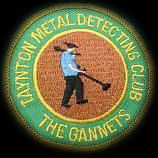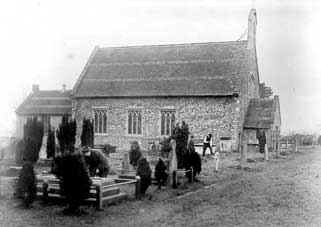
Taynton History
Parish History
The Dobunni
Roman Iron Making
Roman mosaic
Taynton Parva
St Lawrence Church
Glass Making
Brick Yard & Pottery
Brass Mill
WWII
Typhoon Crash
Hampden Crash
US Camp
US Finds
Taynton Metal Detecting Club
The Gannets
St Lawrence Church

|
The church was built during the Commonwealth and was dedicated in 1660. It replaced a Norman church that was situated half a mile away that was burnt down in 1642 by Royalist forces at the time of the siege of Gloucester. It was built on behalf of Thomas Pury the younger who was a Colonel at Gloucester during the siege and who lived at The Grove, Taynton. In defiance of the Catholic tradition it was built on a north /south alignment instead of the usual east/west making it almost unique in England. For a very interesting and comprehensive history read "Taynton Gloucestershire A Story of Two Churches" by Douglas J. Parker. Available from: Court Publications, Tibberton Court, Tibberton, Glos. or Tel 01452790313. Price £3-50. |
When Henry VIII dispossessed the monks of St. Peter's Abbey, amongst those who were found posts as parish priests was Walter Stanley who came to Taynton Church and married soon afterwards. The next rector had also been a monk but came here after serving at St. Michael's Gloucester and at Churcham. He was rector here when Queen Mary returned the country to Catholicism and not all his parishioners were prepared to accept this. Two at least, Home and Crockett, secretly continued the forbidden services in a cave, the site of which in Rocks Wood is still marked by an ancient yew tree. It was well visited at one time, but as accidents occurred there, it was filled in. The two men were discovered and taken to prison. Home managed to escape, and a pathetic story is told of how he returned home secretly. His wife had recently given birth to a child and at the christening feast, the midwife became suspicious when she saw Home's mother cutting large slices of meat from the joint. She told the authorities, who searched and found Home hiding in a barrel. He was taken to Newent and burnt at the stake in the grounds of Newent Priory. What Crockett's fate was is less certain; it is thought that he may have survived Mary's reign and so been released. Both men had been held in esteem in the parish and the story goes that when Elizabeth was securely on the throne the women of the parish, "the men not daring", tied the parson back to front on his horse and drove him out of the parish. Incidentally, this priest heads his registers as 'the raigne of King Phillip and Queene Mary'.
By 1563, the chancel and the church were in "decay" and Rector John Younnis and his parishioners were ordered to repair them. Apparently the chancel was the priest's concern while the congregation had charge of the nave. Eighty years later, the church was to suffer irreparable damage when it was burnt down during the Civil War.
It is difficult to imagine the torture it must have been to families and parishes when they were tom apart by loyalty to one side or the other. Gloucester on the whole was for Parliament, while the Forest area was loyal to the King. This area was between the two, and must have seen much skirmishing between the two sides.
The story is far from clear and seems to depend on the allegiance of the narrator. Certainly, Gloucester's governor, Colonel Massey, led some of his troops out of Gloucester, having heard of Royalist troops in this vicinity, and of the approach of Welsh troops. One version says that his soldiers were, as usual, drunk, and having left the city early, they stopped and shaved themselves in the Ell Brook at what became known as Barber's Bridge. The Royalist troops were in the neighbourhood of Cole's Barn where there was a skirmish. The battle moved down towards Taynton Manor and church where it was thought the Parliament forces had stored arms and powder. Colonel Massey was knocked from his horse and taken prisoner by the Royalists but freed by one of his men. The stored powder was set alight and the church and priest's house were burnt. Another version claims that the Royalist troops were desecrating the church by using it as a shelter for themselves and their horses, which were being watered in the font and that the local people, being Parliamentarians, led by their priest, Ferdinando de Stratford, made determined efforts to oust them. In the confusion, the church was set on fire. There is probably some truth in both stories, although from contemporary accounts of Colonel Massey one would not have expected him to encourage drunken behaviour. Many churches were used as arsenals, Upton Leonard's being one.
The Saint part of the church name was omitted in Cromwell's time. For some years nothing was done; the parish registers were maintained apparently without break, and no mention is made of where services were held. We have recently been told of papers being found at Taynton Court Farm listing local fairs, which suggests that house as a possible meeting place. In 1647, the parishioners requested a new church in a more convenient position and Parliament granted this but nothing was done. Then Thomas Pury, who with his father had done "great work" in the Parliamentary cause and had been member of Parliament for Gloucester, came to live at the Grove and with his help the new church was built.
What the old church looked like we do not know, but about 1700 which is within the memory of people then alive, it was said to have been of stone with a wooden bell tower and one bell. We know that it had a chancel and a nave. In Puritan fashion, Pury rejected all 'Catholic superstitions' and the new Church was aligned North and South like Emmanuel College, Cambridge. It had no chancel but a central table. A pulpit was brought from Trinity Church, Gloucester as that had been destroyed. Sadly the first burial service in the new church was that of the young son of Thomas Pury.
As religious fashions changed, the incumbents of the church tried to align their church in the more usual East/West style and this presented later rectors with problems. The altar table was moved into a place between the last two east windows with the Commandments board serving as a reredos. Large box pews were erected - and rented - by important parishioners and a gallery was installed at the north end over the door. The poor who could not afford their own pews sat in darkness under this gallery.
The Communion Table was attached to the West Wall with the reading desk and projected into the aisle. Later a vestry room which also served as a schoolroom was built on the south side.


In 1892, the parishioners decided to raise money to build a new chancel still at the south end, to replace the gallery and the unsafe box pews with more formal seating and to site the Altar Communion Table and the organ in the new chancel, giving the church its present internal appearance.
Early in its history the church established a chapel near the present Glasshouse Inn on the site of the spring known as Monk's Well or Monk's Spout. Perhaps there was a pagan place of worship here earlier. A villein and later a monk were in charge of this chapel and a cottage there is still Monk's Cottage. The water was of vital importance as the stream, after joining another from the Huntley area, turned the mill near Mote Farm.